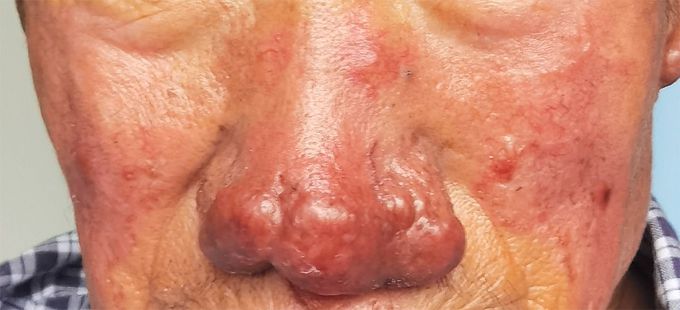


Lupus Pernio in Sarcoidosis
A 71-year-old man presented to the rheumatology clinic with an 8-year history of enlarging nodules on his nose. He reported no fever, weight loss, or respiratory symptoms, but he had a history of iritis of unknown cause. On physical examination, he had painless, violaceous, indurated nodules on his nose, ears, fingers, and toes. The lungs were clear on auscultation. Laboratory studies were notable for an angiotensin-converting enzyme level of 102 U per liter (reference range, 18 to 55). Computed tomography of the chest revealed hilar and mediastinal lymphadenopathy, diffuse fibrosis, and small nodules. Microbiologic examination of the bronchoalveolar-lavage fluid was negative for bacteria, fungi, and mycobacteria, including Mycobacterium tuberculosis. A skin-biopsy specimen of the nose and a transbronchial-biopsy specimen of the lung both showed noncaseating granulomas. A diagnosis of sarcoidosis with lupus pernio was made. Lupus pernio is a cutaneous manifestation of sarcoidosis that is typically characterized by red-to-purple nodules and plaques on the face, especially on the nose. Early recognition and treatment are paramount in avoiding irreversible nasal destruction. Systemic glucocorticoids alone may not adequately treat the lesions. In this patient, treatment with systemic glucocorticoid therapy was initiated, and at a follow-up visit 6 months after presentation, the nodules had abated.
Living with Lupus is often a battle not just against the illness itself, but also against the emotional weight of uncertainty, fatigue, and the toll of long-term medications. For one courageous woman, that battle began in 2013. Diagnosed after Lupus had already affected her joints and internal organs, she was quickly placed on medication that initially helped. But as time went on, her health declined again this time with more frequent flare-ups and increasingly difficult side effects. Like many others with chronic illness, she faced the crushing weight of hopelessness. Each day became harder than the last, and conventional treatments no longer offered the comfort they once did. But in March 2020, at her lowest point, she made a decision that changed everything.Out of desperation and with a healthy dose of skepticism she turned to NaturePath Herbal Clinic, hoping their natural Lupus treatment might offer at least some relief. What happened next went far beyond her expectations.After completing a six-month herbal program, her flare-ups stopped entirely. Her energy returned. The chronic pain that had defined her daily life began to fade. For the first time in years, she felt like herself again. Not just alive but truly living.Her story is not just one of healing; it’s one of resilience, open-mindedness, and the courage to try something new when all else fails. By sharing her journey, she hopes to offer something priceless to others living with Lupus: hope.This treatment has been a true breakthrough for her. If you’re searching for a safe, natural, and effective alternative, I genuinely recommend giving this a chance.”www.naturepathherbalclinic.com or email them at info@naturepathherbalclinic.com


